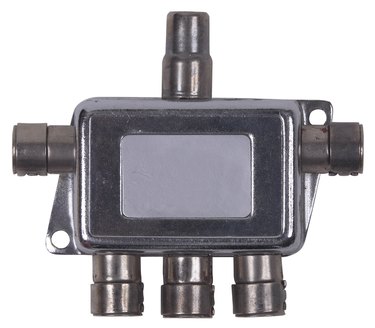
Coaxial cables carry an array of video information, sourced from cable, satellite, and antenna systems. Dividing these signals is achieved primarily through splitters, diplexers and signal taps. These function in different key ways, allowing you to install your coaxial cables in a way that supports your signal distribution needs with a minimum of signal loss.
Taps
Video of the Day
Coaxial taps are low-loss devices used to feed multiple televisions or decoder set-top boxes in a given space. Common places for coaxial tap use are in schools, businesses, and barracks environments where multiple displays must be fed from a common signal source. The coaxial lead from the source is called the trunk line, screwed to the tap's input where the signal experiences roughly 1 decibel of signal loss. Each television is then connected to the tap. The tap device includes an output leg, leading to another tap and so on. Taps have varied levels of attenuation, with the highest attenuation device installed first, gradually reducing down the chain.
Video of the Day
Splitters
Splitters are considered more of a "dead-end" device, where a single feed from the outside feed is divided a certain number of times. Unlike a tap, the signal experiences 3.5 decibels of loss. Splitters are usually limited to four outputs to prevent excessive loss. It is important to not "stack" splitters, since this loss is additive. Once a signal loses roughly 12 decibels of signal, very often the decoder or tuner cannot reconstruct the original feed.
Diplexers
Diplexers are in effect "reverse splitters" used to combine and re-divide signals. Commonly used to join antenna and satellite dish outputs for running over a single feed, diplexers are used in installations that leverage existing coaxial cables. These simple devices are suitable substitutes for a second coaxial run. However, a second diplexer must be used at the decoder box, separating the satellite and antenna signals into two separate feeds leading into the decoder.
Amplified Splitters
Amplified splitters are devices that incorporate a built-in booster, using AC power. These devices often have an adjustable potentiometer, allowing the user to raise or lower the amount of signal from the booster as needed. These devices mitigate the effects from multiple splits and longer coaxial cable runs exceeding 200 feet, where losses usually test the limits of the signal.